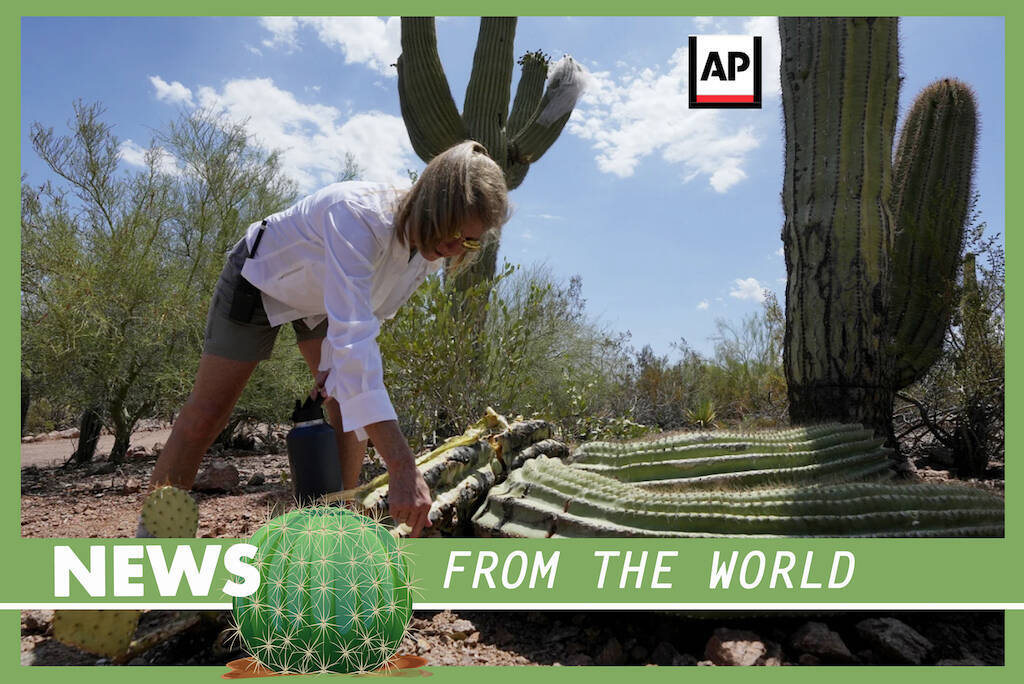Were it not for the fact that national newspapers and international agencies report the news, one would have to think of yet another fake news. Instead, unfortunately, everything is true: the anomalous heat wave that has been hitting Arizona in recent weeks – not unlike the heat bubble that gripped Italy until a few days ago – it’s hitting hard the giants of the desert, i.e. the “Saguaros”. Hard to believe, but even the symbolic cactus, the cactus par excellence, is unable to cope with the excessive heat that is oppressing Arizona, an American state which also has its symbol in the Saguaro (Carnegiea gigantea). In other words, plants that have evolved to cope with drought for thousands of years are literally falling apart, ravaged by temperatures.
Here, in this article, is what is happening as reported by authoritative sources such as TGCOM24 and AP (Associated Press). (…)
“The excessive heat wave in Arizona is killing even the saguaros, the giant cacti typical of the Sonoran desert, not far from Phoenix“, reports TGCOM24. “The Desert Botanical Garden – continues the article published online yesterday – has recorded a death of these plants due to the prolonged period of high temperatures”. This is perhaps a not entirely new phenomenon, but undoubtedly worrying, also in consideration of the fact that the Carnegiea gigantea is a colossus which in nature can reach a dozen meters in height with a circumference of the stem of almost three meters. The so-called Saguaro is the only species belonging to the genus Carnegiea and is native to the Sonoran Desert, in Arizona and in the southern California area, but its range extends west of the Colorado River, up to the Mexican state of Sonora. It is a cactus with a columnar habit, which over time (not before 70 years) emits the characteristic lateral branches, assuming the characteristic candelabrum habit, and which can live up to 170 years (although there are sources which date some specimens to 200 years).
Carnegiea gigantea: cultivation card.
Well, the area affected by the extreme heat is around Phoenix (Arizona). The Associated Press writes about it: “After posting the hottest monthly average temperature on record in any U.S. city in July, Phoenix returned to dangerously high temperatures Wednesday. That could spell trouble not only for people but for some plants. Residents across the sprawling metropolis are finding that prolonged extreme heat has wrought damage and have shared photos and videos of their damaged cacti at the Desert Botanical Garden. Nurserymen and landscapers are inundated with requests for help with saguaros or fruit trees that are losing their leaves”.

The main problem, according to what TGCOM24 reports, is that in these weeks there is no drop in night temperatures and this prevents the plants (not just the cacti) from recovering from the extreme heat that persists during the day. In other words, notes TGCOM24, “plants are unable to cool down, therefore they become dehydrated and are more subject to infections and attacks by insects“. In this regard, again according to what is reported by TGCOM24, the scientist Tania Hernandez declared: “These cacti adapt to the heat but at a certain point they need to cool down and rain is also needed”.
Needless to say, this is an information that any cactus and succulent plant grower should already know well, but it is certainly useful to reiterate the concept and keep it in mind.
From what the Associated Press learns, “At the Desert Botanical Garden, three of the treasured institution’s more than 1,000 saguaro cacti have toppled or lost an arm in the past week, a rate officials say is highly unusual. These saguaros, a towering trademark of the Sonoran Desert landscape, were already stressed by record-breaking heat three years ago and historic heat this summer — the average temperature in Phoenix last month was 102.7 degrees Fahrenheit (39.3 degrees Celsius)” turned out to be the classic coup de grace. Botanical Garden chief scientist Kimberlie McCue told the AP, “Since 2020, we’ve had high mortality in our saguaro population compared to pre-2020 mortality rates. So part of our thinking is that there are still saguaros today that they’ve been compromised by what they went through in 2020. And that could send them over the edge”.
It is generally believed that cacti are built to withstand the heat, and this is certainly true, but McCue explained again, “even they can have their limits. It wasn’t just the series of 31-day highs this summer at or above 110 degrees Fahrenheit (43.3 degrees Celsius), but also multiple nights where the low never dropped below 90 degrees (32.2 degrees Celsius). Nighttime is when cacti open their pores to remove retained water and absorb carbon dioxide”.
In recent years, precisely to cope with the situation and climate change, the Desert Botanical Garden has worked to “propagate cacti that seem more able to withstand scorching conditions after staff members noted that the heat of 2020 was more difficult for some plants than others. Some seemed to have a genetic makeup that allowed them to thrive”. McClue therefore concludes in the article published by the Associated Press: “We want to try to capture it (the genetic composition; ed) and grow more saguaro from seeds to add to our population in the garden with the idea that over time this will bring more resilience in the our population”.
The photo published above is taken from the official website of the Associated Press.
SUBSCRIBE TO THE SITE – If you liked this article, subscribe to the site to have access to all the contents for one year or three months depending on the formula you choose. Here you will find terms and conditions.
SUBSCRIBE TO THE NEWSLETTER – If you want to receive the free newsletter every time new content is published (even if you have not subscribed to the site), fill in the fields at this link!
Correlated articles
Knowledge and curiosity
Cactus cultivation cards
Wild cultivation
© The texts, videos, photos and graphic elaborations of the site “Il fiore tra le spine” are original material and are covered by copyright. It’s forbidden to reproduce them in any way.



